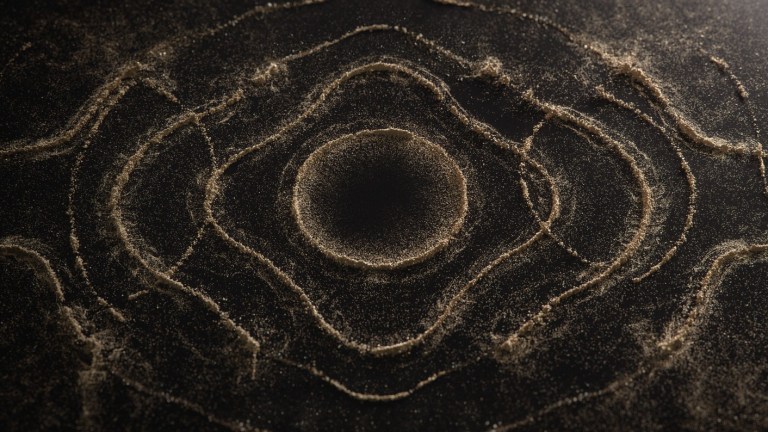The Rings of Power: The “Secret Code” for Fans to Decipher in the Opening Titles
The creators of the exquisite Rings of Power opening titles explain the abstract game they’ve been playing with Tolkien fans…

The Lord of the Rings: The Rings of Power is a sprawling, ambitious, and visually arresting series, so it makes sense that its opening title sequence would reflect those same elements. Over the course of 90 seconds, glistening grains of sand and pebbles of stone swirl through a complex pattern of morphing shapes and symbols inspired by the writings of J.R.R. Tolkien.
But creators Katrina Crawford and Mark Bashore of the Seattle-based studio Plains of Yonder had an even more daunting task than many viewers may have initially realized: To not only create a sequence that felt true to the world of The Rings of Power but one that served as something of a visual crash course in the history of the Second Age in which it is based.
“Every time we take on a project, we research heavily,” Bashore tells Den of Geek. “We learn as fast as we can, as much as we can before we even ideate. And especially—I saw we, but it’s actually mostly Katrina, who has got a science background and is very able to take really complicated subjects and boil down their essence really quickly.”
Though Crawford admits to reading and loving the books as a child, she hesitates to put herself on the same level as the “researchers and experts” that have dedicated their professional lives to the works of Tolkien.
“I read them all as a kid. I was into it,” Crawford laughs. “But there’s people who can speak Elvish! And I think, if anything, we just wanted to have the utmost respect and appreciation for that. And we had a plethora of help from the show as well. We had a CG expert who was there, and a Tolkien person we consulted on [the meaning of] some of the icons.”
Though there are plenty of images that eagle-eyed Tolkien fans are likely to identify throughout the opening credits, from a pair of trees that could represent anything from the two Trees of Valinor to the White Tree of Numenor or its later descendant, the White Tree of Gondor. There’s an object that looks a lot like a silmaril and a steadily encroaching vein of dark sand that could easily represent Melkor, Morgoth, or even Sauron.
“I think everything is built with almost a double or a triple meaning,” she says. “Take, for instance, the island of Numenor—it shows as a map, but it’s also in transition. It’s between two different things, so [its meaning] is somewhat hidden. There’s meaning in terms of the history of Numenor and what happens to it. There’s a whole story there. But there’s also a story in just that transition as well—that realms rise and fall and the idea of time in Tolkien is so important.”
Rings and ring shapes also show up throughout the title sequence, rotating in groups of nine (for the rings of men), seven (for those that belong to the dwarves), and three (for the elves) before being dominated by a single larger, central circle (for the one to rule them all).
“We kind of set out to make this little art film, something that maybe the inside fans or the literary versions of Tolkien fans would understand immediately,” Bashore says. “The sacred geometry, it’s right there. But to maybe many people, they’re like ‘Why am I watching sand dance around?’ So it’s a little bit coded, like a great book cover where you’re like this is a whole world filled with a lot of different things, but it’s kind of disguised as an abstract.”
The final product was one of several ideas pitched to the series’ showrunners, Patrick McKay and J.D. Payne, who the pair described as “the most earnest, die-hard fans” of the Tolkien universe. “They love it, and they just want to make a great thing,” Crawford says.
But neither Crawford or Bashore “wanted to try and recreate the show” in their opening sequence, but rather create “a vibe” the same way that “great abstract art” does.
“Whether it is a piece in the museum or a sculpture where you’re like I see a horse or I see energy, or I see sadness or whatever—it’s in a little bit in the eye of the beholder. And, it sounds cheesy, but it’s not explicit. You bring your own meaning to it.”
Instead, the pair views the title sequence as more of a jumping off point for the story that the show is telling.
“We view them as portals,” Crawford adds. “Kind of like a doorway. We’re going to take you through to this world and hopefully get you in the right mood or frame of mind so that you can enjoy it more. And if you pick up on things that maybe feel like they add to the story then we’ve succeeded.”
It took the pair “about seven months” and “hundreds” of iterations before landing on the sequence’s final form, using a “super experimental process” that required a lot of trial and error to get right.
“Part of it is CG magic,” Crawford admits. “And part of it is real. We use a phenomenon called cymatics, which is physics. It’s acoustics. It’s when a certain frequency vibrates on a metal plate. And they [create] an exact formation and they form different shapes depending on the frequency of a sound. So if you play a certain tone, it will go and make a certain shape.”
The end result is a combination of live-action footage and computer-generated animation, all of which attempted to lean into the imperfections inherent in cymatics itself.
“We experimented a ton. We just used all kinds of different things,” she continues. “The live parts are mixed in with the CG so that you get this beautiful realistic organic feel. And, the computers are amazing. We couldn’t have done this without computers, but you also need that organic component, that flaw and mystery. And that part of it comes from the live action elements.”
Both Crawford and Bashore essentially sound like wizards while talking about this process and sound positively in awe of how it all works.
“Some things will make the most intricate designs that blow your mind,” she continues. “You’re just like, that’s not real. That is magic. And so, since that’s such a huge theme for the show—just good old-fashioned, imaginary magical forces—it felt really aligned. Just real primordial magic.”
Within the credits themselves, there isn’t a single dominating image or “hero shot” that viewers are meant to latch onto. Rather, the morphing icons offer an overarching sense of eternity and the cyclical nature of eras that mirrors many of Tolkien’s larger themes.
“There’s more of a hero theme,” Bashore explains, “which is that across millennia, things come and things go. It’s the way life is, right? And so, the sand does things—appearing and dissolving sort of at the same time is kind of a perfect metaphor for a lot of things, but definitely for Tolkien’s world and across millennia, thousands of years before the Peter Jackson movies. “
The constant flow of the sand across the screen was also something the pair thought keenly about, from the physics behind the motion itself to what it was meant to imply in a larger, more spiritual sense.
“How do you portray a lot of time passing and civilizations rising and falling, or even a universe being created?” Bashore says. “It’s that fleeting thing that we were really vibing on and you just feel it, it’s not really explicit. [But] we liked the idea of this loop. So [the credits] begin with just these grains of sand sort of starting to pull together, and it ends with dust. It begins and ends with nothingness and you can almost take the beginning and the end and loop them around to each other. It’s sort of this cycle, the piece ending as it began.”
The ultimate effect is one that feels almost magical, as though the shapes within the sand are formed by some sort of ancient and invisible hand. Which, in its way, also makes perfect sense—-in Tolkien’s world the universe is literally sung into existence in a sort of musical Big Bang by immortal angelic beings known as the Ainur. And so, The Rings of Power’s opening credits are literally built from sound.
“That’s what we aimed [for]—that’s the vision. That you’re seeing sound. The sound is in the driver’s seat. And this is [something that] is almost reacting to the music versus a movie that’s set to music. I think people sometimes underestimate how powerful the ears are in a film, so we wanted it to be about that. We hope anyway, that it’s not making a spectacle of itself visually at the expense of the sound, but that the two are adding up to be much stronger than the sum of their parts.”
Bashore and Crawford weren’t able to see any of The Rings of Power while working on the title sequence, and “only got a verbal description” of specific story elements from its showrunners. Thankfully, the pair did get to hear the haunting title theme composed by Howard Shore—who also did the music for Peter Jackson’s Oscar-winning trilogy of Lord of the Rings films— in advance of putting the opening sequence together, something which they both considered a key piece of its overall success.
“[As soon as] they chose the concept, that was the first question. It was like, we need music right away because this thing will fail [without it]. So that was the first thing we did was really, really push for the main structure of the music.”
“Because it’s born from sound— I mean, that’s the idea,” Crawford chimes in “You’re seeing sound visualized. So, they had to be together and Howard Shore was great in [helping with] that. We sent him an edit in-process and he tweaked some things and added some requests and things that we had asked. So, he was very kind and adjusted a little bit to help us with this vision of trying to make this world.”
Both Bashore and Crawford recognized that not everyone tuning into The Rings of Power would be an expert in Tolkien lore or have ever even heard of things like the Ainulindalë, let alone know the specifics of the creation myth at the heart of the author’s fantasy world.
“It’s about respecting people where they are,” Crawford adds. “To have things that work for people, no matter what level they’re at, is really nice. Some people are going to pick up on things and they’ll have a whole depth of meaning in them. For other people, they see it in a kind of looser sense.”
However, the duo also purposefully created the titles in such a way as to allow the show’s audience to “develop a new understanding” as they “get more information each week.”
“We purposely haven’t been explaining in great detail to icons because as they come up, you understand more and we’ll talk about them more,” Crawford says. “But we don’t want to spoil it. We want to give respect to the people watching and give them a reason to watch.”
For his part, Bashore is enjoying watching viewers search for meaning in the world he and Crawford have created.
“A lot of main titles are very on the surface. What you’re seeing is exactly whatever it is,” he explains. “And, this is not that. It’s a little bit more of a secret code and we’ve found viewers tend to really appreciate that aspect. They appreciate playing the game with you.”
The Lord of the Rings: The Rings of Power is streaming now on Amazon Prime Video.
